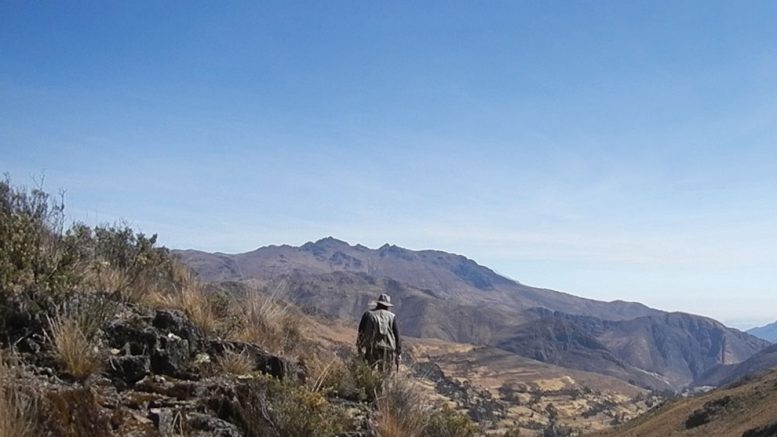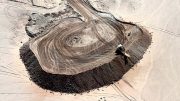Chakana Copper (TSXV: PERU; US-OTC: CHKKF) has launched a fully-funded, 15,000-metre drill program at its Soledad copper-gold-silver project in Peru, with a target date of March 2021 to release its first resource estimate.
Soledad is in the country’s Ancash district, 35 km southwest of Barrick Gold’s (TSX: ABX; NYSE: GOLD) Pierina gold mine and 260 km northwest of Lima. Gold Fields (NYSE: GFI) invested in Chakana Copper last year and holds a 16.8% stake in the junior.
So far, the company has drilled a total of 30,273 metres, testing seven of 23 confirmed breccia pipes that outcrop, with more than 92 targets. It has one drill rig testing gold-enriched tourmaline breccia pipes, but will add a second once it gets enough definition drilling lined up to justify the second rig.

Chakana Copper’s project team at the Soledad copper-gold-silver project in the western ranges of the Andes in Peru in 2017. From left: Carlos Montoya, project manager; Steve Park, chief consulting geologist; Favio Medrano, field assistant; David Kelley, CEO; and Victor Torres, project geologist. Credit: Chakana Copper.
“We have so many targets on the property that the strategy is, we’ve ranked all of our targets and we’d like to do initial scout drilling, about six to eight drill holes into each target,” David Kelley, the company’s president and CEO, says in an interview from Vancouver. “If we see mineralization right away we will put in a few more drill holes. The idea is to answer three questions: Is it mineralized? Is there indication of high-grade? And can we get some sense of the geometry?”
If the target isn’t mineralized, the drill moves on, Kelley says. “Almost all pipes that are mineralized have high grade. It’s a matter of where the high grade is located,” he explains. “The high-grade is often on the margins of the pipe, and sometimes it’s throughout the pipe.”
In July, Peruvian authorities granted the company permission to drill in the central part of the project, which hosts some of the highest priority areas that have significant surface and geophysical anomalies that haven’t yet been drilled. These include the Paloma East and Paloma West targets and the nearby Huancarama breccia complex. The central portion of the project is 500 metres south of the northern part of the project where previous drilling was completed.
Its phase three drill program began in August, and in September Chakana released results from three of five holes drilled at the Paloma East target.
Highlights include a 15 metre intercept grading 0.31 gram gold per tonne, 38.8 grams silver per tonne and 2.10% copper (2.36% copper-equivalent) from 45 metres downhole, within a broader 173 metre intercept starting from surface grading 0.31 gram gold, 13.2 grams silver and 0.34% copper (0.66% copper-equivalent) in drill hole SDH20-135. The hole also returned a 9 metre intercept grading 1.57 grams gold, 15.6 grams silver and 0.14% copper starting from 5 metres downhole. Drill hole SDH20-133 returned 16 metres grading 0.50 gram gold, 24.2 grams silver and 0.89% copper (1.42% copper-equivalent) starting from 132 metres.
Based on the company’s current modelling, the shape of the Paloma East target increases from a diameter of 25 metres at surface to about 50 metres at a depth of 150 metres.
Kelley notes that exploration results so far suggest that the fundamental characteristic of the breccia pipes at Soledad is that the overall footprint increases at depth. “Most breccia pipes get bigger at depth when you drill them,” he explains. “We estimated they were somewhere in between one and two kilometres depth below surface when they formed and with uplift and erosion in the Andes, these breccia pipes have been exposed at surface.”
Kelley notes that in the first four holes drilled at Paloma East to the northeast and northwest, the geometry was “basically a cylinder increasing at depth.”
“We had 15 metres of 2.1% copper and that’s outstanding high grade for us,” he says. “We had a shallow zone with 1.57 grams gold per tonne in it, so there’s good gold enrichment at the top of the breccia pipe and good copper grades near the bottom.”

Drillers targeting Breccia Pipe #1 at Chakana Copper’s Soledad project in the western ranges of the Peruvian Andes. Credit: Chakana Copper.
One of the drill holes, SDH20-137, for which assays are still pending, exited tourmaline breccia at a depth of 627 metres, he adds, far beyond the anticipated depth of 170 metres down hole.
“In general the breccia pipes have an inverted carrot shape with the tip of the carrot at the top, and as you go down the carrot gets bigger. We were assuming that is what we had, so we expected to get out of the breccia pipe at 170 metres depth and there was still breccia, and we continued drilling and continued drilling, and we didn’t exit the breccia until 627 metres depth. That was really amazing.”
The drill hole also ended up directly below the company’s Paloma West target at a depth of about 530 metres, Kelley continues. “What it showed us is that instead of having Paloma East and Paloma West separated by 150 metres, we have breccia at depth, expanding the entire extent of those two breccia pipes … It’s basically open in all directions and at depth so there is a lot of drilling that needs to be done.”
One of the project’s potential upsides, Kelley explains, is that the breccia pipes coalesce at depth, and that and is now the company’s working hypothesis. If they do, he says, “it gives you a lot bigger playing field, it expands your host rock dramatically. Again, we need to drill in different directions, but just having a lateral extent like that suggests we have a much larger volume of breccia within which mineralization could be hosted.”
Since optioning the project in 2017 from Condor Resources (TSXV: CN), Chakana has tripled its land position to more than 30 square kilometres.
“It’s fun – it’s a lot of fun – it’s amazing,” Kelley says of exploration at Soledad. “It’s why we do this. There are a lot of people in the industry who do it to make money, but most geologists that I know are in the business because they love what they do. It’s hard to make a discovery these days. It’s harder and harder, so when you come across something like this, it’s exciting, and I do believe this could become a major discovery. We’ve only really scratched the surface.”
Drill results from the northern part of the project area released in the past two years included four breccia pipes— Bx7, Bx1, Bx5 and Bx6 — all of which contain pervasive mineralization and are vertically extensive.
Drilling at Bx7 returned 31 metres of 0.68 gram gold, 205.9 grams silver and 0.23% copper (2.44% copper-equivalent) from 157 metres depth. The number seven pipe is about 340 metres northeast of the number one breccia pipe.
Bx1 was drilled to a depth of 490 metres and remains open. Highlights include hole 17-18, which returned 209 metres from surface of 1% copper, 2.22 grams gold and 70 grams silver (3% copper-equivalent). Hole 18-59 intersected 233 metres from surface of 0.85% copper, 1.4 grams gold and 57 grams silver (2.24% copper-equivalent), and hole 18-77 cut 244 metres from surface of 0.91% copper, 1.4 grams gold and 56 grams silver (2.3% copper-equivalent).

Chakana Copper CEO David Kelley (left) and chairman Douglas Kirwin outside the Royal Ontario Museum in Toronto, where some of Kirwin’s mineral and ore collection is on display. Photo by Trish Saywell.
Chakana also found a blind breccia body 40 metres north of Bx1. Unlike the Bx1 pipe, which crops out at surface, the top of the blind pipe is at a depth of 125 metres. The company’s geologists believe it’s possible that the two pipes coalesce at depth.
The Bx5 pipe, 1 km northwest of Bx1, is not as high grade. Drill hole 17-41 returned 164 metres of 0.51% copper, 1.7 grams gold and 27.4 grams silver (2.8% copper-equivalent) starting from a depth of 12 metres. Hole 18-80 cut 264 metres from surface of 0.71% copper 1.3 grams gold and 24.3 gram silver (2.7% copper-equivalent).
Results from Bx6, 500 metres north of Bx5 and 1,000 metres northwest of Bx1, and traced down to 800 metres’ depth, include 18-103, which intersected 29 metres of 0.76% copper, 1.2 grams gold and 227.7 grams silver (3.52% copper-equivalent) starting from 64 metres downhole, and 18-107, which returned 14 metres of 1.92% copper, 3.8 grams gold and 13 grams silver (4.54% copper-equivalent) starting 86 metres downhole.
Kelley notes that Chakana’s timing is good given the strong fundamentals for copper.
“Copper has a great fundamental story. There is a looming supply gap in copper that relates to mines going out of production, decreasing grades, disruptions to operating mines, and the fact that we haven’t been finding copper deposits at the same pace as they were found in the previous century,” he says. “We used to be very good about finding new deposits. Why has it dropped off? The world is really picked over, we’ve explored the most obvious places and now you either have to find new terrains to explore, or apply different models and explorations approaches in terrains that have been explored before.”
Kelley adds that Chakana is using its experience in tourmaline breccia systems to explore Soledad, and his team has an “understanding and knowledge of these systems” that “a lot of our competitors don’t, and we’re taking advantage of that.”
In addition, the Soledad project contains interesting gold enrichment, which feeds into the booming market for gold projects, he says.
“Copper has a great story but what is stealing all the headlines is the bull market in precious metals, investments in gold, and there has certainly been some evidence that people are pulling money out of base metal investments into gold investments. But the nice thing about Soledad is that it’s an investment in a copper-gold-silver deposit, so if you like copper, invest in Chakana, if you like gold and silver, invest in Chakana, it has all three.”
With the recent changes in metal prices, he adds, about 70% of Soledad’s current value is in gold and silver and 30% in copper.
“Even though we’re drilling some significant copper grades of between 0.5% and 1% copper, you have gold and silver on top of it,” he says. “That’s the key message. If you’re torn between copper and precious metals, invest in us because you get exposure to all three metals.”




Be the first to comment on "Chakana Copper drills Soledad project in Peru"